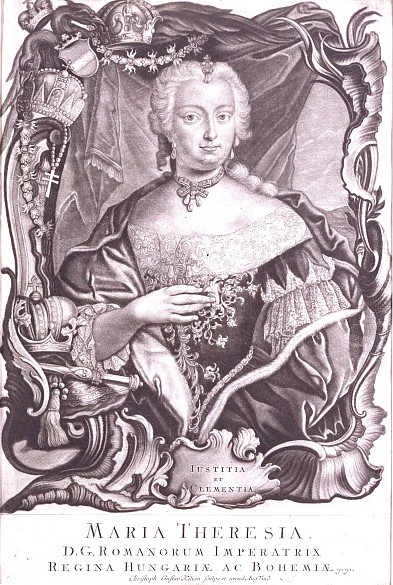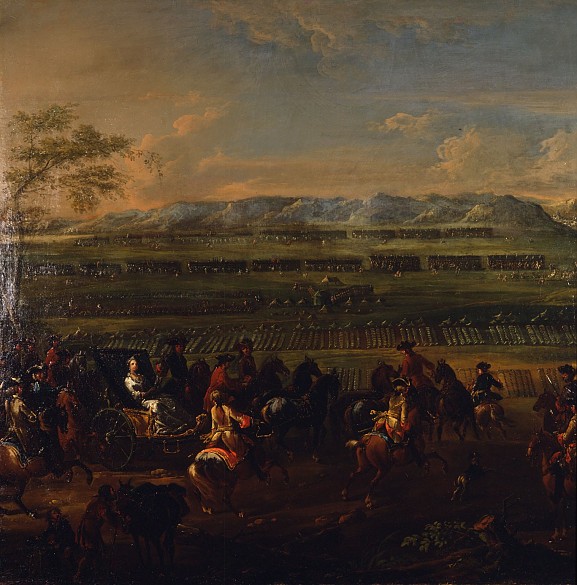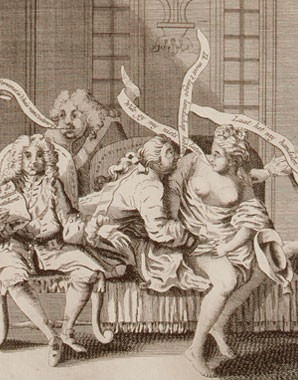The War of Austrian Succession
The Habsburg Monarchy was on the brink of disaster. Maria Theresa’s claim to her inheritance had not been recognized by some of the European Powers. In 1740 the Prussian king Frederick the Great invaded Silesia, firing the starting shot in the War of the Austrian Succession. Until peace was concluded at Aix-la-Chapelle in 1748 the country was in a state of war.
Soon after her father’s death Maria Theresa found herself confronted with the claims of German princely dynasties who saw themselves as having equal rights as heirs to the Habsburg dynasty through marriage to the daughters of Emperor Joseph I – that is, Maria Theresa’s cousins.
As the husband of Maria Josepha, elder daughter of Joseph I, Elector Friedrich August of Saxony represented the claims of his wife. Elector Karl Albrecht of Bavaria made demands in the name of his wife Maria Amalie, Joseph’s younger daughter. An anti-Habsburg alliance formed between Bavaria, Saxony and France with the aim of partitioning the Monarchy.
The start of hostilities was marked by the invasion of Silesia by Prussian troops in December 1740. Having only recently come to power, the young King Frederick II of Prussia took advantage of the situation and occupied the province in the north-east of the Monarchy without declaring war.
Other powers followed suit and invaded Habsburg territories. The War of the Austrian Succession had broken out. In July 1741 allied French and Bavarian troops occupied Upper Austria and Bohemia. The Elector of Bavaria then received the homage of the Bohemian Estates as King of Bohemia. No actual coronation took place as the insignia had already been taken to safety in Vienna.
In the search for allies Maria Theresa managed to bring Britain, Russia and the Netherlands onto her side. In retrospect, the struggle with Prussia for Silesia was the decisive conflict, but constituted only a part of the War of the Succession, which took place in many different theatres of war. At first hostilities broke out on Austrian territory against Bavarian invaders. Soon the action moved to Bavaria, and from there to the Rhine, where Habsburg troops fought side by side with their allies against France.
Maria Theresa’s position was strengthened by her coronation in Hungary in June 1741. This was an important event that had great symbolic effect: Maria Theresa was now a rightfully crowned monarch and was able to secure the loyalty of the Hungarian Estates.
Nonetheless, in the Holy Roman Empire the Austrians suffered a setback: Maria Theresa’s husband Franz Stephan was unsuccessful in his bid to become a candidate for election as emperor. In 1741 the electors chose the Wittelsbach prince Charles VII as head of the empire. The House of Austria thus lost a title that it had retained uninterruptedly from the middle of the fifteenth century and which had constituted the foundation of the special standing of the Habsburgs in Europe.
In the meantime however the tide had turned: while Charles VII was being crowned in Frankfurt Austrian troops occupied Bavaria, and Bavarian power in Bohemia began to totter.
In July 1742 peace was concluded with Prussia, thus ending the First Silesian War. For Maria Theresa this meant ceding most of Silesia together with the county of Glatz (Kladsko; a fiefdom of the Kingdom of Bohemia). Only parts of south-eastern Silesia (Teschen and parts of the duchies of Troppau, Jägerndorf and Neisse) remained under Austrian rule.
In May 1743 Maria Theresa was crowned Queen of Bohemia in Prague, an event that symbolized the successful recovery of power in Bohemia.
However, the peace was short-lived. In August 1744 Prussia once again invaded Bohemia, triggering the Second Silesian War. This was in reaction to Maria Theresa’s successes in pressing her claims against Bavaria and Saxony. The attack on Bohemia was intended to involve Austria in a war on two fronts and thus force her to conclude peace from a weaker position.
In the meantime Emperor Charles VII had died in exile in 1745, after Austrian troops had occupied Bavaria. His successor sued for peace and was restored as ruler of Bavaria. In return Bavaria also pledged to support the election of Franz Stephan as Holy Roman Emperor, which was sealed with his coronation at Frankfurt in September 1745.
In December 1745 the Peace of Dresden was signed, thus ending the Second Silesian War. Prussia’s possession of Silesia was confirmed, and in return it recognized Franz Stephan as Holy Roman Emperor.
The Peace of Aix-la-Chapelle, concluded in October 1748, brought international recognition of Maria Theresa as ruler over the Monarchy and ended the conflict over the Austrian Succession.
The result from the point of view of the Habsburg-Lorraine dynasty was that Maria Theresa had successfully defended the majority of her claims, with the exception of Silesia. Prussia’s new status as a rival power in Central Europe had to be acknowledged. The Holy Roman Empire had diminished in importance; although Maria Theresa’s husband had been recognized as emperor, the empire no longer played as great a part in defining the identity of the dynasty as it had in preceding generations.















